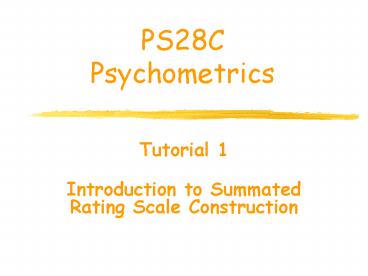PS28C Psychometrics - PowerPoint PPT Presentation
1 / 21
Title:
PS28C Psychometrics
Description:
Purpose of tutorial is to provide practical experience ... Second tutorial reviews APA style ... Development of scales based on classical test theory ... – PowerPoint PPT presentation
Number of Views:48
Avg rating:3.0/5.0
Title: PS28C Psychometrics
1
PS28CPsychometrics
- Tutorial 1
- Introduction to Summated Rating Scale Construction
2
Introduction
- Purpose of tutorial is to provide practical
experience developing summated rating scales - Will work in groups of 3-4
- Group will create a rating scale and examine its
psychometric properties
3
Introduction
- During these tutorials you will learn how to
- Develop a pool of items measuring a psychological
attribute, - Select a few items from this pool to construct a
multi-item summated rating scale, and - Assess the reliability and validity of your
measure
4
Introduction
- Rules for the tutorials
- Turn off cell phones, pagers car alarms
- Attend each tutorial from start to finish
- Be on time for the tutorials
5
Introduction
- Keep a record of your intellectual contribution
- Portion of assignment grade will be based on your
intellectual contribution - Hand in participation sheet with your report
6
Overview of Tutorials
- Today will introduce the process of summated
rating scale construction - Second tutorial reviews APA style
- Third tutorial introduces hypothetical constructs
and use of library resources - Fourth tutorial presents correct question writing
and layout
7
Overview of Tutorials
- Fifth tutorial teaches pilot-testing and
think-aloud interviewing - Sixth tutorial teaches how to construct a
psychometric study - Seventh tutorial involves estimating internal
consistency reliability - Eighth tutorial presents Factor Analysis
8
Overview of Tutorials
- Ninth tutorial describes how to estimate the
validity of your instrument - Final tutorial involves completion of Cattells
16PF
9
Tutorial One
- Summated rating scales very popular in social
sciences - Roots in work of Likert
- Four key features
- Multiple items which are combined
- Each item quantitatively assesses a construct
- No correct or incorrect answers
- Items ask for ratings by respondents
10
Advantages of Rating Scales
- Produce measures that are reasonably reliable and
valid - Inexpensive and easy to develop
- Creating items is straightforward
- Only require 100-200 participants to develop and
assess properties - Relatively easy for respondents to complete
11
Disadvantages of Rating Scales
- Respondents must have the ability to read and
write to answer - Require a moderate amount of statistical
sophistication and expertise
12
Why construct and use multi-item scales?
- Several problems with single item measures
- Produce very unstable or unreliable responses
- Lack precision in measurement
- Can not capture complexity of most psychological
concepts
13
Why construct and use multi-item scales?
- Using multiple items to assess psychological
concepts has many advantages - Allows for many more aspects to be assessed
- Respondents given a wider range of possible
responses - Errors in responding average out over many items
14
Why construct and use multi-item scales?
- Errors in measurement are reduced
- Multiple items allow respondents to be more
easily sorted into groups
15
What makes a good scale?
- Three key characteristics to a good scale
- The items must fully capture the psychological
concept and its behaviour - The scale must be reliable
- The scale must be valid
16
What makes a good scale?
- Other important attributes of a good scale
- The items should be clear, well written and
contain a single idea - The scale should be appropriate for the
population to which it is applied - The scale should be free from response biases
- The scale should not produce defensive responses
17
Steps in Creating Multi-Item Scales
- Five major steps
- Clearly define the psychological attribute to be
measured - Design and layout the draft scale
- Pilot-test the scale
- Collect data on the draft scale and examine
properties of items - Examine the validity of the scale and create norms
18
Theory Of Scales
- Development of scales based on classical test
theory - True score can be distinguished from observed
score - O T e
- Each item is an attempt to assess the true score
19
Theory Of Scales
- Single items unreliable due to large error
- Increasing the number of items reduces the total
error in a scale - Each item measures a separate aspect of the
psychological concept - Errors associated with each item average out
reducing total error - Increasing the number of items reduces the error
20
Formation of Working Groups
- Find two to three other people to work with
- Select a psychological attribute you would like
to measure - Attribute should not be some aspect of
intelligence, ability or aptitude
21
Formation of Working Groups
- Your task is to
- 1) Decide what you wish to measure
- 2) Plan out a schedule of tasks and
responsibilities - Plan a timeline for the completion of your
measure - Report to me who is in your group, the attribute
your group will measure, and your planned schedule































